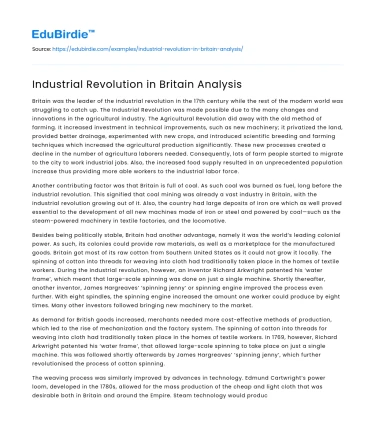Britain was the leader of the industrial revolution in the 17th century while the rest of the modern world was struggling to catch up. The Industrial Revolution was made possible due to the many changes and innovations in the agricultural industry. The Agricultural Revolution did away with the old method of farming. It increased investment in technical improvements, such as new machinery; it privatized the land, provided better drainage, experimented with new crops, and introduced scientific breeding and farming techniques which increased the agricultural production significantly. These new processes created a decline in the number of agricultura laborers needed. Consequently, lots of farm people started to migrate to the city to work industrial jobs. Also, the increased food supply resulted in an unprecedented population increase thus providing more able workers to the industrial labor force.
Another contributing factor was that Britain is full of coal. As such coal was burned as fuel, long before the industrial revolution. This signified that coal mining was already a vast industry in Britain, with the industrial revolution growing out of it. Also, the country had large deposits of iron ore which as well proved essential to the development of all new machines made of iron or steel and powered by coal—such as the steam-powered machinery in textile factories, and the locomotive.
Save your time!
We can take care of your essay
- Proper editing and formatting
- Free revision, title page, and bibliography
- Flexible prices and money-back guarantee
Besides being politically stable, Britain had another advantage, namely it was the world’s leading colonial power. As such, its colonies could provide raw materials, as well as a marketplace for the manufactured goods. Britain got most of its raw cotton from Southern United States as it could not grow it locally. The spinning of cotton into threads for weaving into cloth had traditionally taken place in the homes of textile workers. During the industrial revolution, however, an inventor Richard Arkwright patented his ‘water frame’, which meant that large-scale spinning was done on just a single machine. Shortly thereafter, another inventor, James Hargreaves’ ‘spinning jenny’ or spinning engine improved the process even further. With eight spindles, the spinning engine increased the amount one worker could produce by eight times. Many other investors followed bringing new machinery to the market.
As demand for British goods increased, merchants needed more cost-effective methods of production, which led to the rise of mechanization and the factory system. The spinning of cotton into threads for weaving into cloth had traditionally taken place in the homes of textile workers. In 1769, however, Richard Arkwright patented his ‘water frame’, that allowed large-scale spinning to take place on just a single machine. This was followed shortly afterwards by James Hargreaves’ ‘spinning jenny’, which further revolutionised the process of cotton spinning.
The weaving process was similarly improved by advances in technology. Edmund Cartwright’s power loom, developed in the 1780s, allowed for the mass production of the cheap and light cloth that was desirable both in Britain and around the Empire. Steam technology would produce yet more change. Constant power was now available to drive the dazzling array of industrial machinery in textiles and other industries, which were installed up and down the country.
New ‘manufactories’ (an early word for ’factory’) were the result of all these new technologies. Large industrial buildings usually employed one central source of power to drive a whole network of machines. Richard Arkwright’s cotton factories in Nottingham and Cromford, for example, employed nearly 600 people by the 1770s, including many small children, whose nimble hands made light-work of spinning. Other industries flourished under the factory system. In Birmingham, James Watt and Matthew Boulton established their huge foundry and metal works in Soho, where nearly 1,000 people were employed in the 1770s making buckles, boxes and buttons, as well as the parts for new steam engines.Scottish inventor James Watt’s refinements to the steam engine in 1775 that began the revolution. Up until that point, such engines were crude, inefficient, and unreliable. Watt’s first engines were used primarily to pump water and air into and out of mines.
As more powerful and efficient engines were developed, which would operate under high pressure and thus increase output, new forms of transportation became possible. In the U.S., Robert Fulton was an engineer and inventor who had become fascinated with Watt’s engine while living in France at the turn of the 19th century.
After several years of experimenting in Paris, he returned to the U.S. and launched the Clermont in 1807 on the Hudson River in New York. It was the first commercially viable steamboat line in the nation.
As the nation’s rivers began opening to navigation, commerce expanded along with the population. Another new form of transportation, the railroad, also relied on steam power to drive the locomotives. First in Britain and then in the U.S., rail lines began appearing in the 1820s. By 1869, the first transcontinental rail line linked the coasts. If the 19th century belonged to steam, the 20th century belonged to the internal combustion engine. American inventor George Brayton, working on earlier innovations, developed the first liquid-fueled internal combustion engine in 1872. During the next two decades, German engineers including Karl Benz and Rudolf Diesel would make further innovations. By the time Henry Ford unveiled his Model T car in 1908, the internal combustion engine was poised to transform not just the nation’s transportation system but also spur 20th-century industries like petroleum and aviation.






 Stuck on your essay?
Stuck on your essay?

